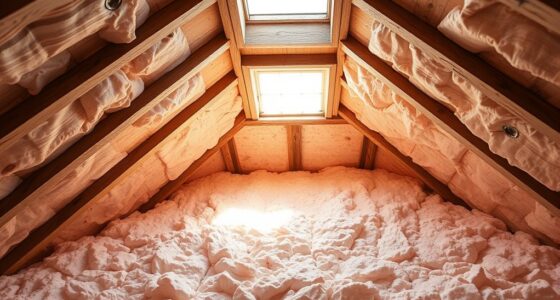To keep your marble floors shining and beautiful, start by dusting and sweeping regularly to prevent scratches. When it comes to mopping, use a pH-neutral cleaner mixed at 2-5 oz per gallon. Avoid acidic products that can damage the surface. Clean spills immediately to prevent stains, and consider applying a food-safe sealant annually, especially in high-traffic areas. Rinse and dry the floors to avoid water spots. Remember to inspect for scratches or dull areas regularly. Each of these steps plays an essential role in maintaining your marble's elegance, and there's even more you can discover to guarantee its lasting beauty.
Key Takeaways
- Clean spills immediately to prevent stains, particularly from acidic substances like coffee and curry.
- Use pH-neutral cleaners mixed at 2-5 oz per gallon for regular mopping to maintain shine.
- Employ microfiber mops to avoid scratches and reduce excess water on marble surfaces.
- Apply a food-safe sealant annually in high-traffic areas to protect against stains and moisture.
- Schedule professional maintenance for deep cleaning and repair to enhance marble's longevity and appearance.
Understanding Marble's Characteristics

When you choose marble for your floors, it's important to understand its unique characteristics. Marble is a beautiful, metamorphic rock, but its porous nature makes it susceptible to stains. Spills from coffee or other liquids can easily seep in, leading to permanent discoloration if not addressed quickly.
Additionally, using acidic cleaners can corrode the surface, causing etching that dulls its shine. To maintain the beauty of your marble floors, you'll need to practice regular preventive care. Address spills immediately and avoid harsh chemicals to preserve its luster. Regular cleaning of surfaces can also help reduce the buildup of dust and allergens in your home, improving overall air quality.
Causes of Yellow Stains
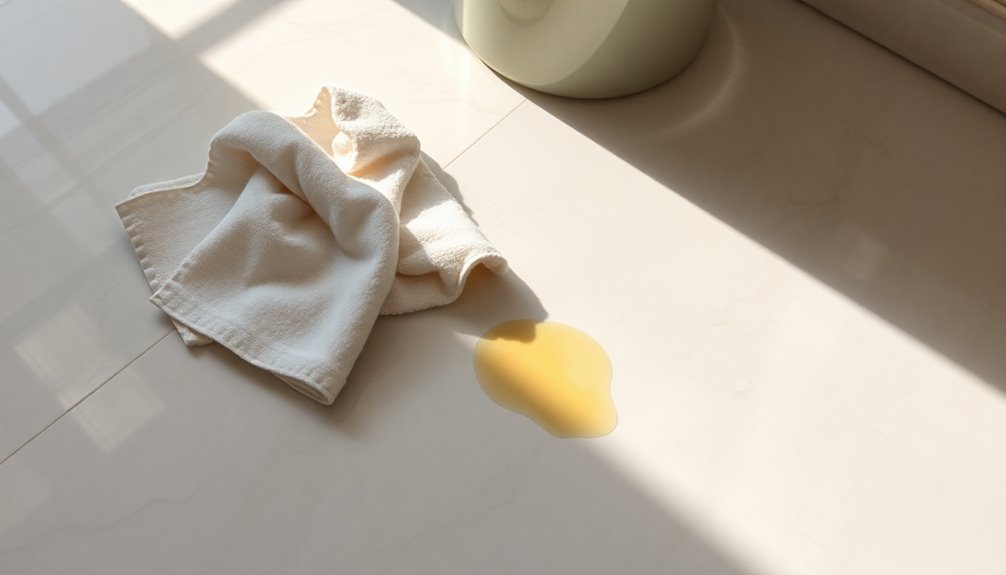
Yellow stains on your marble floors can come from common culprits like coffee and curry, which seep into the stone's porous surface.
Additionally, oxidation of iron in the marble, especially when exposed to moisture, can lead to unwanted yellowing.
If you don't address spills quickly and maintain your floors, you might find those yellow stains becoming a persistent problem.
Common Staining Agents
Marble floors can easily fall victim to various staining agents that lead to unsightly yellow stains.
Being a natural stone, marble is made of calcium carbonate, which makes it porous and absorbent. Common staining agents include acidic substances like vinegar and lemon juice, as well as food items such as coffee and curry.
Using acidic cleaners on marble can exacerbate the problem, causing further discoloration from staining agents. To protect your floors, it's essential to perform immediate cleanup of spills.
Regular maintenance and prompt attention to potential stains will help preserve the marble's original beauty, preventing deeper stains that could be challenging to remove.
Oxidation and Moisture Effects
While many people appreciate the elegance of marble floors, they often overlook how oxidation and moisture can lead to unwanted yellow stains.
The porous nature of marble allows it to absorb moisture and spills, which can cause yellow staining if you don't clean them promptly. Oxidation of iron minerals in the marble can also contribute to a yellowish tint, especially in lighter stones.
High humidity can exacerbate this effect, making it essential to protect your marble from prolonged moisture exposure. Common sources of stains include acidic substances, oils, and pigments from food.
Be cautious with cleaning products; harsh chemicals can react negatively, leading to further discoloration. Regular maintenance is key to keeping your marble floors clean and beautiful.
Effective Cleaning Methods

To keep your marble floors looking their best, using a baking soda paste can tackle tough stains effectively.
Establishing a regular mopping routine with the right cleaning solution will help maintain their shine and prevent dirt buildup.
Let's explore these methods to guarantee your marble stays pristine.
Baking Soda Application
Cleaning marble floors effectively requires the right approach, and baking soda can be a powerful ally in tackling tough stains. To create an effective cleaning solution, mix 2 tablespoons of baking soda with 2 tablespoons of water. Apply the paste to the stain and let it sit for 2-3 hours or overnight. Once done, wipe it away with a damp cloth and rinse with clean water to avoid residue buildup. For ideal maintenance, clean your marble flooring twice a week. Below is a simple guide:
| Step | Action | Frequency |
|---|---|---|
| Mix solution | Combine baking soda with water | As needed |
| Apply paste to stain | Let it sit | As needed |
| Wipe with damp cloth | Rinse with clean water | After each use |
| Repeat | Maintain marble | Twice a week |
Regular Mopping Routine
A regular mopping routine is essential for keeping your marble floors looking their best. Aim to mop weekly using pH-neutral cleaners, like Zep Neutral pH Floor Cleaner, diluted in warm water at 2-5 oz per gallon.
Using a microfiber mop is vital; make sure it's well-wrung to avoid excess water that can lead to staining. After mopping, rinse the floor with clean water to remove any leftover cleaning solution.
Thoroughly dry the area with a soft cloth to prevent water spots. This routine not only maintains the shine of your marble but also prevents dirt and grime buildup that dulls its appearance.
For an extra touch, buff the surface with a soft cloth after it's dry to restore its natural luster.
Daily Maintenance Tips
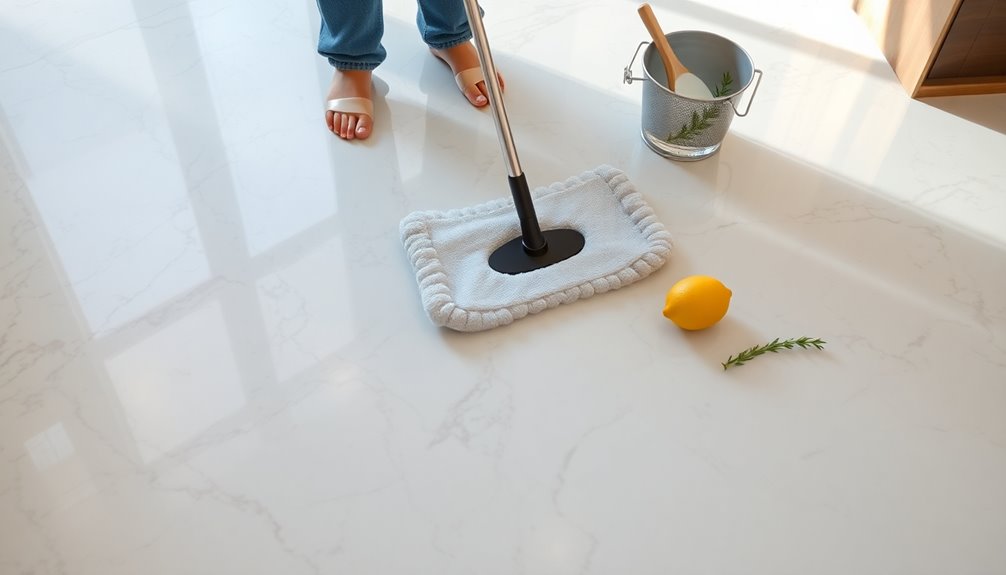
While daily upkeep might seem tedious, staying on top of your marble floors can make a significant difference in their appearance and longevity. Here are some daily maintenance tips to help you protect the surface:
| Task | Frequency | Tips |
|---|---|---|
| Dust Mop | Daily | Use a soft-bristled broom or microfiber dust mop to prevent scratches. |
| Spill Cleanup | Immediate | Gently blot spills with a damp cloth to avoid stains. |
| Sticky Residue Wipe | As Needed | Use a warm, damp cloth; avoid abrasive scrubbing. |
For weekly mopping, use a pH-neutral cleaner mixed with warm water. Regularly inspecting for scratches or dull spots will also help you maintain your beautiful marble floors.
Stain Prevention Strategies
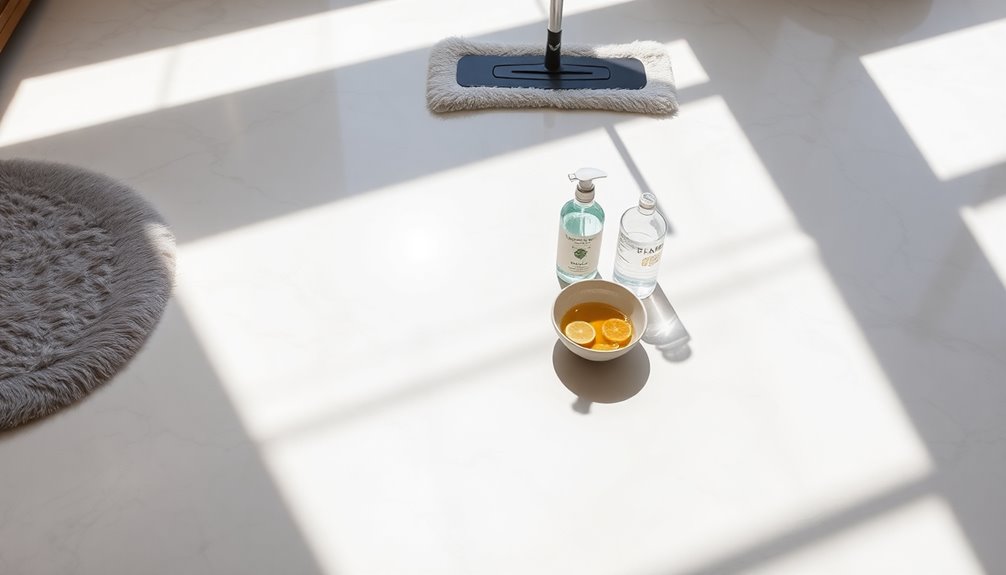
To keep your marble floors looking pristine, it's essential to take proactive steps in preventing stains.
First, clean spills immediately since marble's porous nature can absorb liquids quickly, leading to deep stains. Use coasters and placemats to protect the surface from acidic substances like coffee and wine.
Regularly apply a food-safe sealant to enhance stain resistance; focus on high-traffic areas and seal them annually for best protection.
Additionally, placing rugs or mats in entryways helps trap dirt and debris, reducing scratches and wear.
Finally, avoid acidic cleaners, such as vinegar or lemon juice, as they can strip the sealant and increase the likelihood of staining and dullness, undermining your stain prevention efforts.
Recommended Cleaning Products
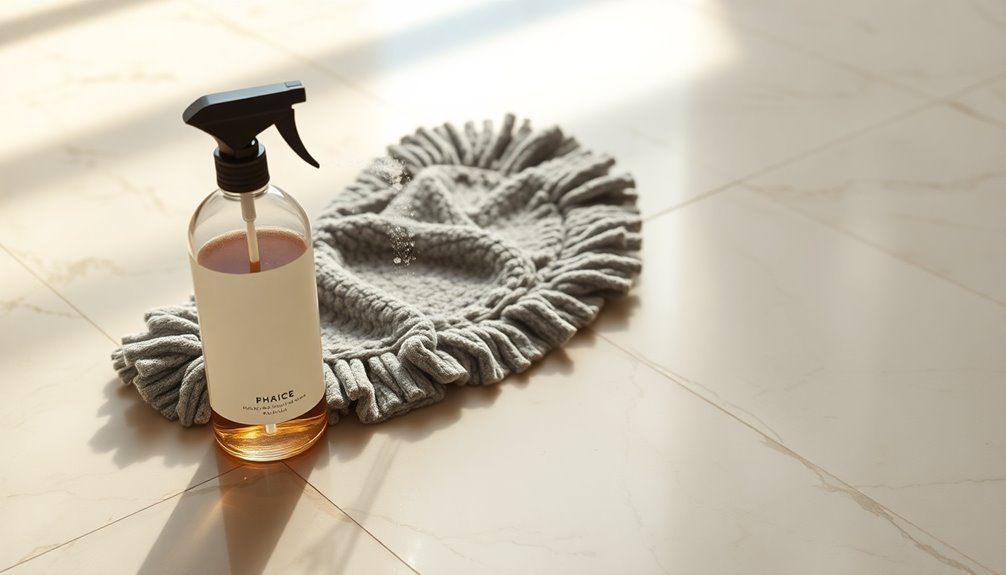
Keeping your marble floors in top condition requires the right cleaning products. To guarantee you’re using the best way to clean, consider these essentials: Start with a pH-neutral cleaner specifically designed for marble surfaces, as acidic or harsh chemicals can dull the finish. Additionally, using microfiber mops or cloths will help prevent scratches while effectively removing dirt and grime. For deeper cleaning, incorporating the best carpet cleaning techniques can also ensure that surrounding areas enhance the overall look of your marble floors by maintaining cleanliness throughout your space.
- pH-neutral cleaner: Use one like Zep Neutral pH Floor Cleaner, mixed at 2-5 oz per gallon of warm water.
- Mild dish soap: Mix with water for regular cleaning. Just make sure it doesn't contain acidic ingredients.
- Microfiber cloths: These are perfect for wiping and drying, reducing scratches and streaks.
- Avoid strong chemicals: Stay away from vinegar, Windex, and bleach, as they can strip the marble's protective seal.
For extra shine, consider using a cleaning paste made from chalk powder and a damp sponge.
A marble sealer can further protect the surface.
Importance of Sealing
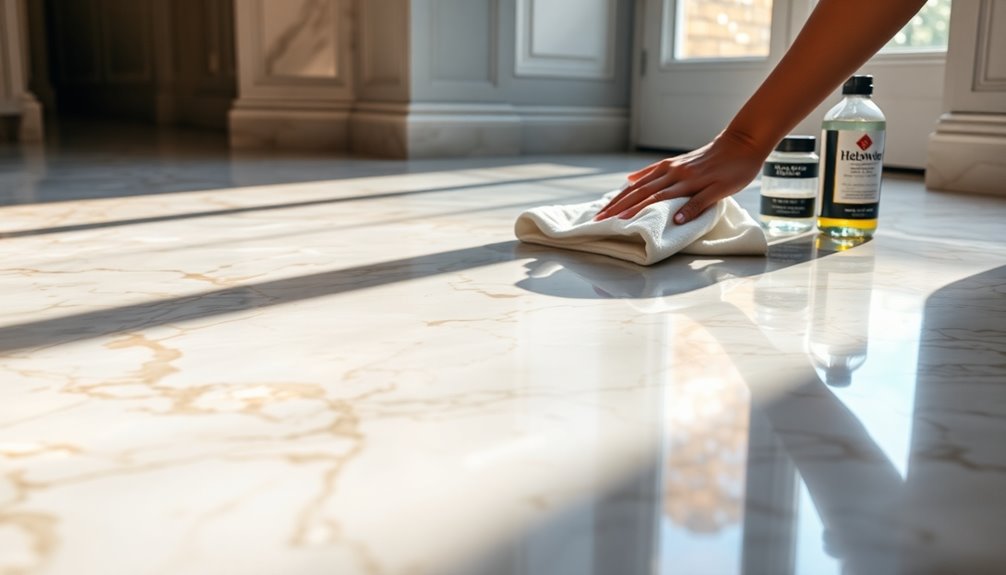
Sealing your marble floors is vital for maintaining their beauty and longevity, as it enhances stain resistance and protects the porous surface from spills and moisture damage.
You should apply a sealer every year, especially in high-traffic areas, to guarantee peak protection. Regular maintenance is essential; perform a water test to check if resealing is necessary.
If water beads on the surface, you're good to go, but if it darkens the marble, resealing is required. Be vigilant for water rings or spots, as these can indicate that the sealant has worn off.
When to Seek Professional Help
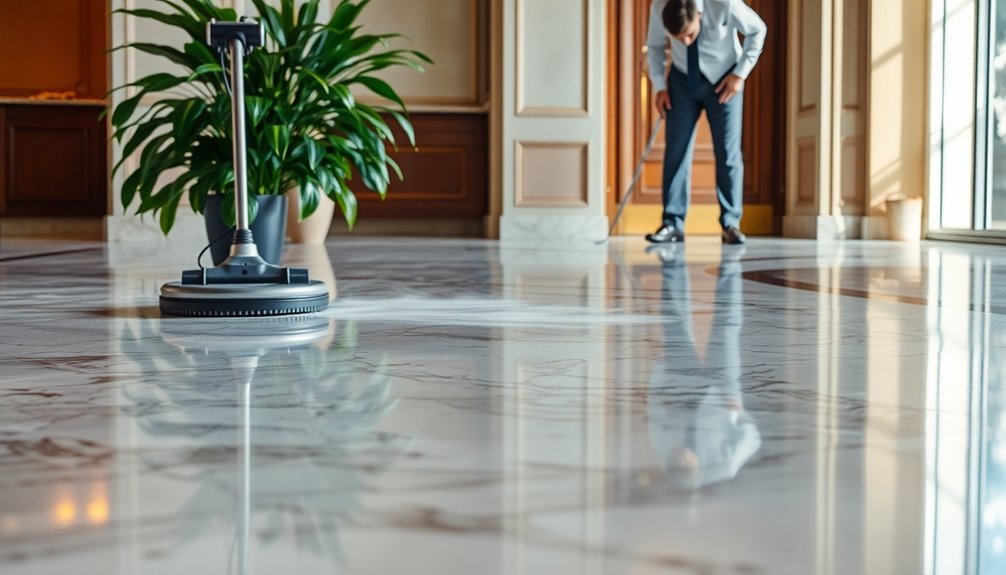
When you notice deep scratches or significant damage on your marble floors, seeking professional help is crucial.
Professionals have the expertise and tools to restore your floors without causing further harm. Here are key signs it's time to call in the experts:
- Visible Scratches: Deep scratches that regular cleaning can't fix.
- Moisture Issues: Signs of efflorescence or moisture problems.
- Dull Appearance: Lack of shine that regular polishing can't achieve.
- Uncertainty with Products: When you're unsure about which cleaning products to use.
Regular maintenance, including polishing and expert advice, can extend the life of your marble surfaces.
Don't risk damage—consult professionals to guarantee the best care and preservation of your beautiful floors.
Frequently Asked Questions
How to Keep Marble Floors Clean and Shiny?
To keep your marble floors clean and shiny, start by dust mopping or sweeping regularly to prevent dirt buildup.
Mop weekly with a pH-neutral cleaner, rinsing afterward to remove residue.
For stubborn stains, use a baking soda paste, letting it sit before wiping it away.
Avoid harsh cleaners, and remember to apply a marble sealer every 6-12 months to protect the surface and maintain its natural shine.
Your marble will thank you!
How Do You Make Dull Marble Shine Again?
Imagine your dull marble floors transformed into a gleaming surface that catches the light.
To make them shine again, mix baking soda and water to create a paste. Apply it to the marble, letting it sit for several hours. After rinsing, buff it dry with a soft cloth.
For ongoing shine, use a pH-neutral cleaner regularly and consider sealing the marble every 6-12 months to keep it looking stunning.
What Cleaner Makes Marble Shine?
To make your marble shine, you should use pH-neutral cleaners specifically designed for stone. These won't damage your marble or its sealant.
A mix of mild dish soap and warm water works wonders too, enhancing shine without causing etching. You might also consider eco-friendly plant-based cleaners for a glossy finish.
For best results, apply a food-safe marble sealer every 6-12 months to protect and maintain that beautiful luster.
How Do You Seal and Shine Marble?
Did you know that untreated marble can absorb liquids and stains within just 30 minutes?
To seal and shine your marble, start by cleaning the surface with a mild detergent and water.
Once it's dry, apply a food-safe sealant every 6-12 months.
After sealing, use a high-quality marble polish or specialized cleaner to restore its shine.
Regularly buffing with a soft cloth will keep your marble looking stunning and lustrous!
Conclusion
To keep your marble floors looking pristine, regular maintenance and proper cleaning techniques are essential. Imagine walking on gleaming, stain-free marble every day—doesn't that sound inviting? By understanding the unique characteristics of marble and implementing effective cleaning methods, you can preserve its natural beauty for years to come. Don't forget to seal your floors and be proactive about stains. If things get tough, don't hesitate to call in the professionals for help!



